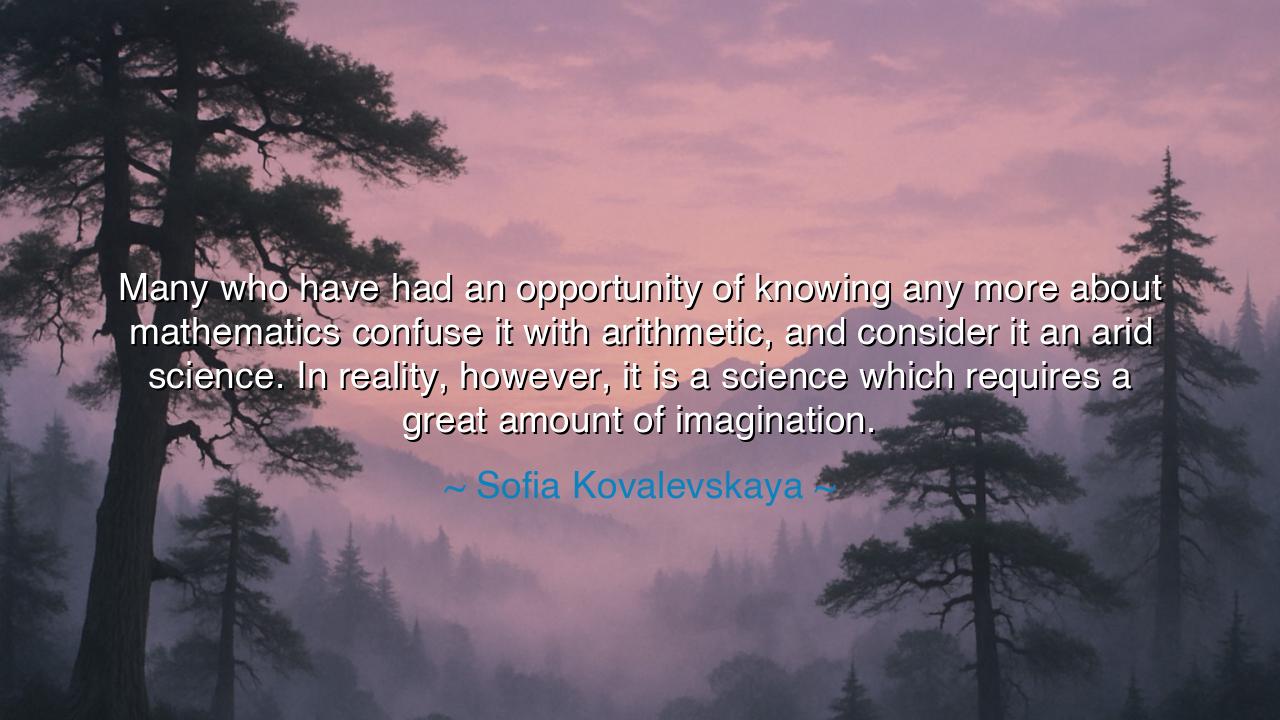
Many who have had an opportunity of knowing any more about
Many who have had an opportunity of knowing any more about mathematics confuse it with arithmetic, and consider it an arid science. In reality, however, it is a science which requires a great amount of imagination.






When Sofia Kovalevskaya declared, “Many who have had an opportunity of knowing any more about mathematics confuse it with arithmetic, and consider it an arid science. In reality, however, it is a science which requires a great amount of imagination,” she spoke not only as a mathematician, but as a visionary who had seen the divine fire that lives within numbers. Her words rise like a challenge against the common misunderstanding of mathematics as a cold, mechanical pursuit. To her, it was not the dry counting of figures, but a living art, born of curiosity, beauty, and above all, imagination. It was, she believed, a bridge between logic and dream, where reason meets creativity and order reveals the infinite.
The origin of this quote lies in the remarkable life of Kovalevskaya herself—a woman of the nineteenth century who defied the walls of her time. Denied entry to universities because of her gender, she pursued her studies in exile, fueled by sheer determination and love for the abstract. For her, mathematics was not a constraint, but a liberation. Through its symbols and equations, she glimpsed the harmony of creation itself. She saw what others could not see—that numbers are not dead signs upon paper, but living ideas, expressing the pulse of the universe. And so, when she spoke of imagination, she spoke as one who had looked beyond the formulas into the infinite dance they describe.
To Kovalevskaya, arithmetic—the simple manipulation of numbers—was but the shadow of the greater light of mathematics. Arithmetic counts; mathematics envisions. Arithmetic measures what is; mathematics imagines what could be. For every theorem that is proven, there must first exist a vision, a spark of intuition that leaps beyond the visible and into the unseen. The mathematician, she believed, is not merely a craftsman but a creator, conjuring structures of thought that mirror the cosmos itself. Like the poet who weaves language into meaning, or the artist who brings color to life, the mathematician uses imagination to shape the invisible into clarity.
Consider the story of Albert Einstein, who once said, “Imagination is more important than knowledge.” Though remembered as a physicist, his revolution began in mathematics. Before he wrote a single equation, he dreamed—he imagined himself riding upon a beam of light, traveling through space and time. From that act of pure imagination arose the theory of relativity, one of humanity’s greatest intellectual triumphs. Einstein’s discoveries were not born from calculation alone, but from the same creative impulse that moves the artist and the mystic. Thus, as Kovalevskaya foresaw, even the most precise sciences are grounded in the imaginative spirit.
It is a mistake, therefore, to think of mathematics as cold or lifeless. Those who see only its symbols do not perceive its soul. The ancients understood this well: Pythagoras spoke of the music of the spheres, believing that numbers were divine harmonies shaping all existence. For him, to study mathematics was to contemplate the order of heaven itself. Kovalevskaya, centuries later, revived that ancient flame in modern thought. She knew that every equation holds within it not merely truth, but beauty—a beauty that must be felt as much as understood. The mathematician’s imagination does not seek escape, but enlightenment; it turns thought into revelation.
Yet her words carry a lesson beyond mathematics. She reminds us that imagination is the foundation of all knowledge. Without it, science stagnates, art withers, and the spirit of humanity grows dull. The progress of civilization is nothing more than the flowering of imagination guided by intellect. We must not separate the two, as so many have done—reason without imagination is lifeless, and imagination without reason is chaos. The balance of the two births wisdom, invention, and truth.
So, my listener, take this teaching to heart: whatever your craft or calling, cultivate your imagination as diligently as your skill. When you encounter a problem, do not only analyze—also dream. Look beyond the surface of things, for in every pattern hides a deeper beauty. Do not fear abstraction or complexity; embrace them, for they are the languages of creation. Let your mind become both scientist and artist, both thinker and dreamer.
For as Sofia Kovalevskaya teaches, the greatest discoveries are not born from calculation alone, but from courage—the courage to imagine. The same spirit that moves the mathematician to map infinity dwells within every soul that dares to wonder. Therefore, honor your imagination, for it is the bridge between the known and the eternal. And remember always: even in the coldest symbols, there burns the warmth of creation, and even in the strictest logic, there breathes the fire of the human spirit.






AAdministratorAdministrator
Welcome, honored guests. Please leave a comment, we will respond soon